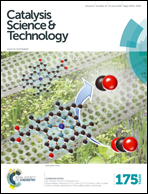Understanding synergetic effects of Zn and Rh–Cr promotion to wide-bandgap Ga, Ta and Ti oxides in photocatalytic water splitting†
Abstract
Promotion of semiconductor metal oxides by specific chemical elements is a widespread approach to enhance photocatalytic water splitting activity. An extraordinary boosting of activity has been recently reported by Zn (dopant) and Rh–Cr (co-catalyst) promotion to Ga-oxide-based photocatalysts. Herein, we report the general applicability of the effectiveness of the promotion strategy used for Ga oxides to Ta and Ti oxides in water splitting under UV irradiation using a slurry reactor. Photophysical characterization (photoluminescence and its decay) was used to clarify the specific roles of Zn and Rh–Cr and their synergetic catalytic action. Our experiments indicate that Zn acts as a booster of charge separation lifetime. Zn promotion alone, however, does not trigger a great boost in catalytic activity in the absence of Rh–Cr. It is only when Rh–Cr is added that the charge separation boost is fully exploited and driven within the catalyst towards overall water splitting. Effective wavelength ranges of the excitation UV light source were also investigated in detail, leading to questioning the dominant semiconductor bandgap model for this class of catalysts.



 Please wait while we load your content...
Please wait while we load your content...